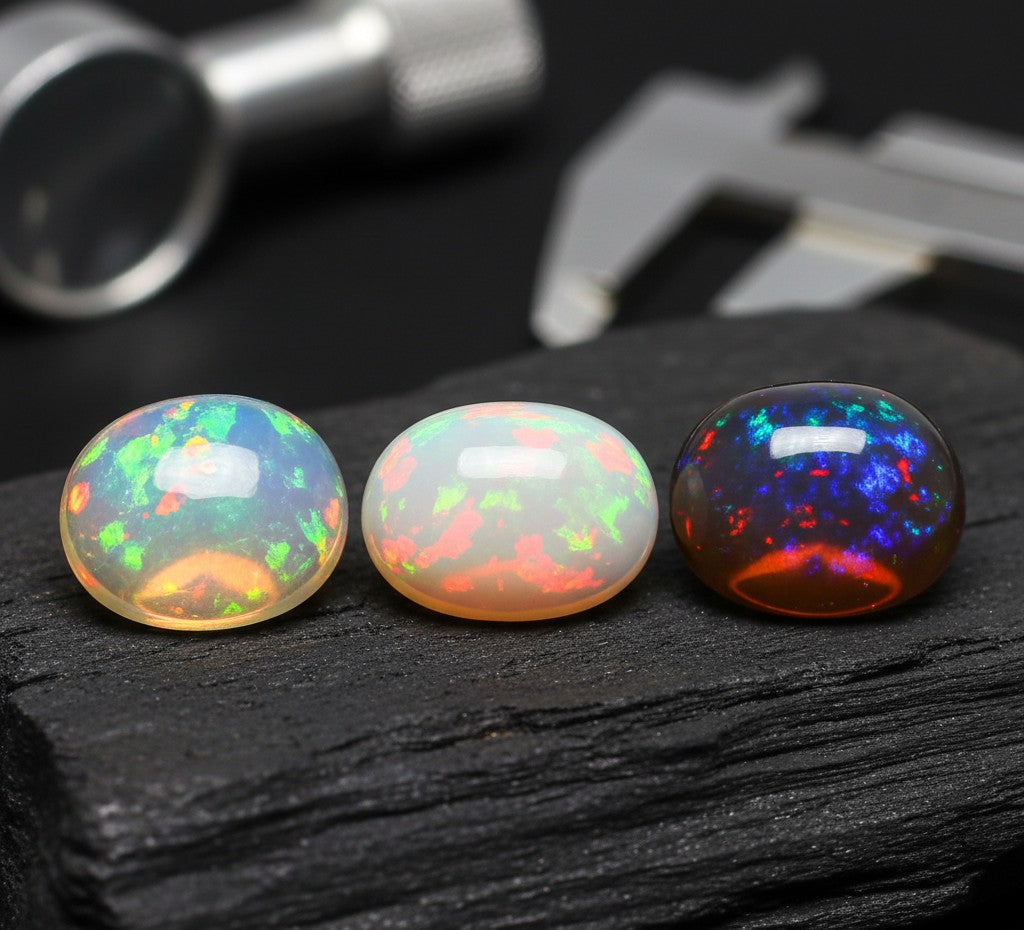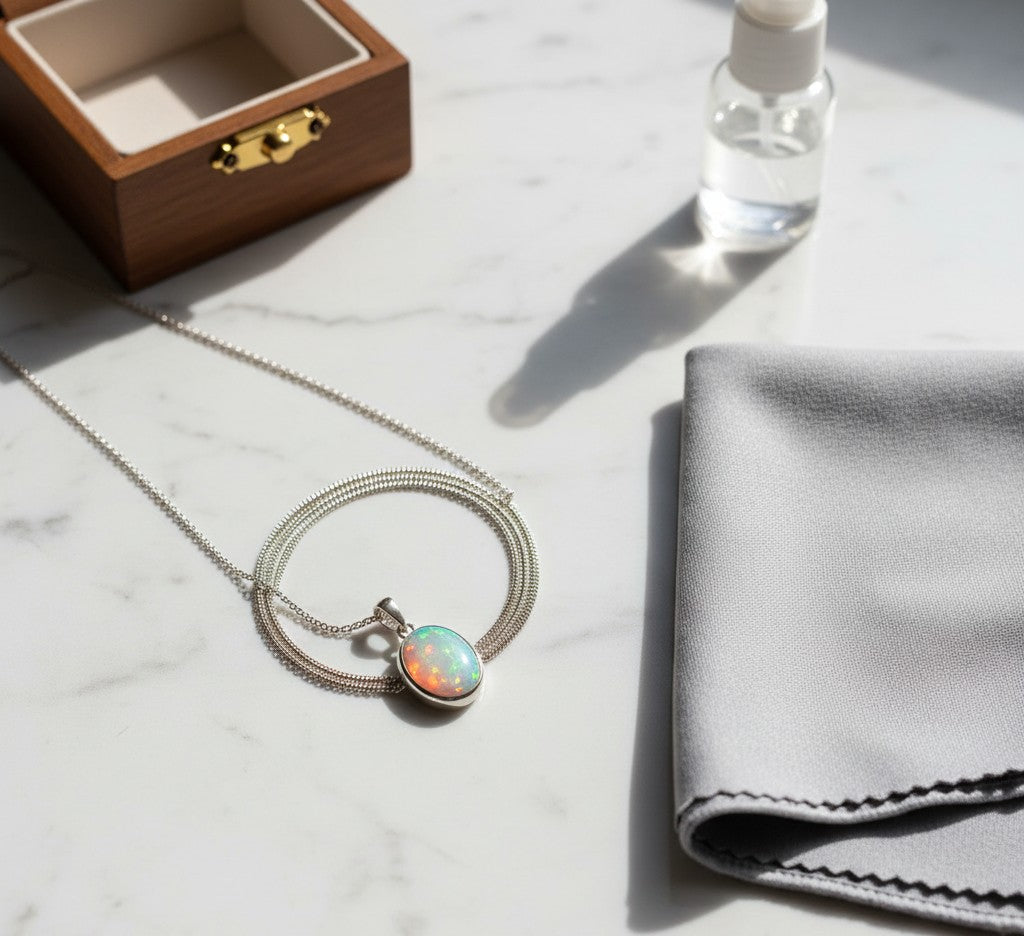Article: Decoding the Fire: Understanding the Value and Pricing of Authentic Ethiopian Opals

Decoding the Fire: Understanding the Value and Pricing of Authentic Ethiopian Opals
The allure of Ethiopian opal is undeniable. Its vibrant flashes of color, seemingly alive with an inner fire, have captivated gem lovers and jewelry designers alike. But what determines the value of these mesmerizing gemstones? Why do some command significantly higher prices than others? In this guide, we'll delve into the fascinating world of Ethiopian opal pricing, focusing exclusively on 100% authentic, solid opals—no lab-grown stones, doublets, or triplets.
Understanding the value of a natural Ethiopian opal is about appreciating the unique combination of factors that nature has bestowed upon it. Unlike manufactured gems, each opal is a one-of-a-kind masterpiece. Here are the key elements that contribute to its price:
1. Play-of-Color: The Dazzling Dance of Light
This is arguably the most crucial factor in determining an opal's value. "Play-of-color" refers to the magnificent display of spectral hues that dance across the stone's surface as it moves.
-
Color Richness and Range: Opals that display a full spectrum of vibrant colors, especially the rarer and highly sought-after reds and oranges, are more valuable than those showing only blues and greens. A stone that flashes three or more distinct colors is highly desirable.
-
Intensity and Brightness (Fire): The brilliance of the color flashes is paramount. A bright, vivid fire that is visible from a distance and in various lighting conditions will command a much higher price than a stone with a dim or subtle play-of-color. Gemologists often grade brightness on a scale from 1 (faint) to 5 (brilliant).
2. Body Tone: The Canvas for the Color
The "body tone" is the base color of the opal, against which the play-of-color is displayed. Ethiopian opals come in a fascinating range of body tones:
-
Crystal and White Opals: These are the most common, with a translucent to opaque white body. The value is driven by the intensity of the fire against this light background.
-
"Chocolate" or Brown Opals: Found in the Mezezo region, these opals have a rich brown body color, which can create a stunning contrast for the play-of-color.
-
Black Opals: While much rarer than their Australian counterparts, natural black Ethiopian opals do exist. Their dark body tone makes the play-of-color pop dramatically, placing them at the highest end of the value spectrum.
A crystal opal that is water-clear or "jelly" and has a spectacular play-of-color is exceptionally rare and valuable.
3. Pattern: The Artistry of Nature
The arrangement of the color flashes forms a pattern, and some patterns are more desirable and rarer than others.
-
Harlequin: A pattern of large, distinct, diamond-shaped or square patches of color is one of the rarest and most valuable.
-
Broad Flash: Large, sweeping flashes of color that cover a significant portion of the stone's surface.
-
Pinfire: Small, pinpoint flashes of color scattered across the surface.
The larger and more distinct the patches of color, the higher the value of the opal generally is.
4. Carat Weight and Size
As with most gemstones, size matters. Larger opals are rarer than smaller ones, so the price-per-carat tends to increase significantly as the size of the stone increases, assuming all other quality factors are equal. A large, 5-carat opal with brilliant, multi-colored fire will be worth much more than five 1-carat opals of the same quality.
5. Clarity and Inclusions
The clarity of an Ethiopian opal, especially in crystal varieties, is important. A stone with high transparency and minimal inclusions (like sand or rock matrix) is more desirable. Cracks or "crazing" on the surface will drastically reduce an opal's value.
6. Cut and Shape
The skill of the cutter is to maximize the opal's play-of-color and brilliance. A well-cut stone with a good dome (cabochon) will showcase the fire from multiple angles. While standard ovals and rounds are common, unique freeform shapes that highlight the best patterns of a particular rough stone can also be highly valued.
Why Authenticity is Key: Solid vs. Doublets/Triplets
It's crucial to understand the difference between a solid, authentic opal and assembled stones like doublets and triplets.
-
Solid Opal: A single, whole piece of natural opal. All the opals we carry are solid stones.
-
Doublet: A thin slice of opal glued to a dark backing (often ironstone or plastic) to enhance its color.
-
Triplet: A thin slice of opal with a dark backing and a clear, domed cap (usually quartz or plastic) on top for protection and magnification.
While doublets and triplets have their place, they are not as valuable or rare as solid opals. The price of an authentic, solid Ethiopian opal reflects its natural, untouched beauty.
A Gem of Great Value
Ethiopian opals offer an incredible value proposition in the gemstone world. They provide a spectacular and often more accessible alternative to other opal types, like those from Australia, without compromising on beauty or fire.
When you purchase a piece of authentic Ethiopian opal jewelry, you're not just buying a stone; you're acquiring a unique piece of natural art. By understanding the factors that contribute to its price, you can better appreciate the rarity and individual character of your chosen gem. Explore our collection and find the perfect piece of fire to call your own.


Leave a comment
This site is protected by hCaptcha and the hCaptcha Privacy Policy and Terms of Service apply.